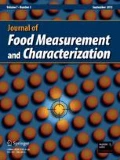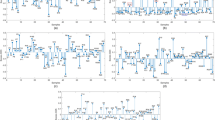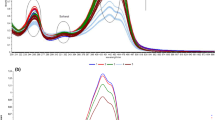Abstract
Near infrared reflectance (NIR) spectroscopy combined with multivariate data analysis was used to discriminate between the geographical origins of yerba mate (Ilex paraguayensis St. Hil.) samples. Samples were purchased from the local market and scanned in the NIR region (1100–2500 nm) in a monochromator instrument in reflectance. Principal component analysis (PCA), partial least squares discriminant analysis (PLS-DA) and linear discriminant analysis (LDA) were used to classify the samples based on their NIR spectra according to their geographical origin. Full cross validation was used as validation method when classification models were developed. The overall classification rates obtained were 76 and 100% using PLS-DA and LDA, respectively. The results demonstrated the usefulness of NIR spectra combined with multivariate data analysis as an objective and rapid method to classify yerba mate samples according to their geographical origin. Nevertheless, NIR spectroscopic might provide initial screening in the food chain and enable costly methods to be used more productively on suspect specimens.




Similar content being viewed by others
References
R. Filip, P. López, G. Giberti, J. Coussio, G. Ferraro, Phenolic compounds in seven South American Ilex species. Fitoterapia 72, 774–778 (2001)
C.I. Heck, E.G. De Mejia, Yerba Mate tea (Ilex paraguariensis): a comprehensive review on chemistry, health implications, and technological considerations. J. Food Sci. 72, R138–R151 (2007)
R. Giulian, R. dos Santos, S. Shubeita, L.M. da Silva, M.L. Yoneama, J. Ferraz-Dias, The study of the influence of industrial processing on the elemental composition of meat tealeaves (Ilex paraguariensis) using the PIXIE technique. LWT-Food Sci. Technol. 42, 74–80 (2009)
V.S. Pires, D. Guillaume, G. Gosmann, E.P. Schenkel, Saponins from Ilex dumosa, and erva mate (Ilex paraguariensis) adulterating plant. J. Agric. Food Chem. 45, 1027–1031 (1997)
S. Surkan, O. Albani, L. Ramallo, Influence of storage conditions on sensory shelf life of yerba mate. J Food Qual. 32, 58–72 (2009)
G. Grigioni, F. Carduza, M. Irurueta, N. Pensel, Flavour characteristics of Ilex paraguariensis infusion, a typical Argentine product, assessed by sensory evaluation and electronic nose. J. Sci. Food. Agric. 84, 427–432 (2004)
G. Gosman, E.P. Schenkel, O. Seligmann, A new saponin from mate, Ilex paraguayensis. J. Nat. Prod. 52, 1367–1369 (1989)
M.N. Cliford, J.R. Ramirez-Martinez, Chlorogenic acids and purine alkaloid content of mate (Ilex paraguayensis) leaf and beverage. Food Chem. 35, 13–21 (1990)
M. Kawakami, A. Kobayashi, Volatile constituents of green mate and roasted mate. J. Agric. Food Chem. 39, 1275–1279 (1991)
R.G. Brereton, Chemometrics. Data Analysis for the Laboratory and Chemical Plant (Wiley, UK, 2003), p. 489
D. Cozzolino, Near infrared spectroscopy in natural products analysis. Planta Med. 75, 646–757 (2009)
P.R. Arhurst, M.J. Dennis, Food Authentication (Chapmann-Hall, London, 1996), p. 315
G. Downey, Qualitative analysis in the near infrared region. Analyst 119, 2367–2375 (1994)
G. Downey, Authentication of food and food ingredients by near infrared spectroscopy. J. Near Infrared Spec. 4, 47–61 (1996)
I. Murray, L. Aucott, I.H. Pike, Use of discriminant analysis on visible and near infrared reflectance spectra to detect adulteration of fishmeal with meat and bone meal. J. Near Infrared Spec. 9, 297–311 (2001)
L.M. Reid, C.P. O’Donnell, G. Downey, Recent technological advances for the determination of food authenticity. Trends Food Sci. Technol. 17, 344–353 (2006)
M.J. Adams, Chemometrics in Analytical Spectroscopy. RSC, Analytical Spectroscopy Monographs (The Royal Society of Chemistry, Cambridge, UK, 1995)
C. Cordella, I. Moussa, A.-C. Martel, N. Sbirrazzuoli, L. Lizzani-Cuvelier, Recent developments in food characterization and adulteration detection: technique-oriented perspectives. J. Agric. Food Chem. 50, 1751–1764 (2002)
D. Cozzolino, H.E. Smyth, M. Gishen, Feasibility study on the use of visible and near-infrared spectroscopy together with chemometrics to discriminate between commercial white wines of different varietal origins. J. Agric. Food Chem. 51, 7703–7708 (2003)
E.K. Kemsley, Discriminant analysis of high-dimensional data: a comparison of principal components analysis and partial least squares data reduction methods. Chem. Intell. Lab. Syst. 33, 47–61 (1996)
T. Naes, T. Isaksson, T. Fearn, T. Davies, A User-Friendly Guide to Multivariate Calibration and Classification (NIR Publications, Chichester, 2002)
M. Otto, Chemometrics: Statistics and Computer Application in Analytical Chemistry (Wiley-VCH, Hemsbach, 1999)
R.J. Barnes, M.S. Dhanoa, S.J. Lister, Standard normal variate transformation and de-trending of near-infrared diffuse reflectance spectra. Appl. Spectrosc. 43, 772–777 (1989)
Ch.E. Miller, Chemical principles of near infrared technology, in Near infrared technology in the agricultural and food industries, 2nd edn., ed. by P.C. Williams, K.H. Norris (American Association of Cereal Chemist, USA, 2001), pp. 19–39
I. Murray, The NIR spectra of homologous series of organic compounds, in Proceedings of the International NIR/NIT Conference, ed. by J. Hollo, K.J. Kaffka, J.L. Gonczy, Akademiai Kiado, Budapest, pp 13–28, 1986
D.H.M. Bastos, E. Ishimoto, M.M. Marques, A.F. Ferri, A.F.S. Torres, Essential oil and antioxidant activity of green mate and mate tea (Ilex paraguariensis) infusions. J. Food Compos. Anal. 19, 538–543 (2006)
A.V. Goodchild, F.J. El Haramein, A. Abd El Moneim, H.P.S. Makkar, P.C. Williams, Analysis of phenolics and tannins in forage legumes by near infrared reflectance. J. Near Infrared Spectros. 6, 175–181 (1998)
C.A. Roberts, J. Stuth, P.C. Flin, Analysis of forages and feedstuff, in Near Infrared Spectroscopy in Agriculture, ed. by C.A. Roberts, J. Workman, J.B. Reeves (American Society of Agronomy, Crop Science Society of America, Soil Science Society of America, Madison, 2004), pp. 231–269
W.R. Windham, S.L. Fales, C.S. Hoveland, Analysis for tannin concentration of Sericea lespedeza by near infrared reflectance spectroscopy. Crop Sci. 28, 705–708 (1988)
Author information
Authors and Affiliations
Corresponding author
Rights and permissions
About this article
Cite this article
Cozzolino, D., Restaino, E. & Fassio, A. Discrimination of yerba mate (Ilex paraguayensis St. Hil.) samples according to their geographical origin by means of near infrared spectroscopy and multivariate analysis. Sens. & Instrumen. Food Qual. 4, 67–72 (2010). https://doi.org/10.1007/s11694-010-9096-y
Received:
Accepted:
Published:
Issue Date:
DOI: https://doi.org/10.1007/s11694-010-9096-y




